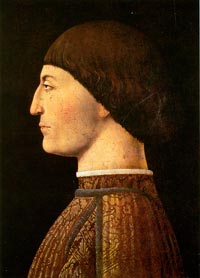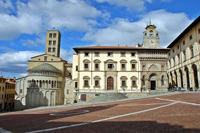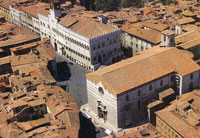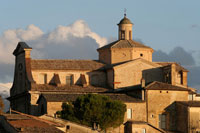| |
|
| |
|
|
|
|
|
|
| |
 |
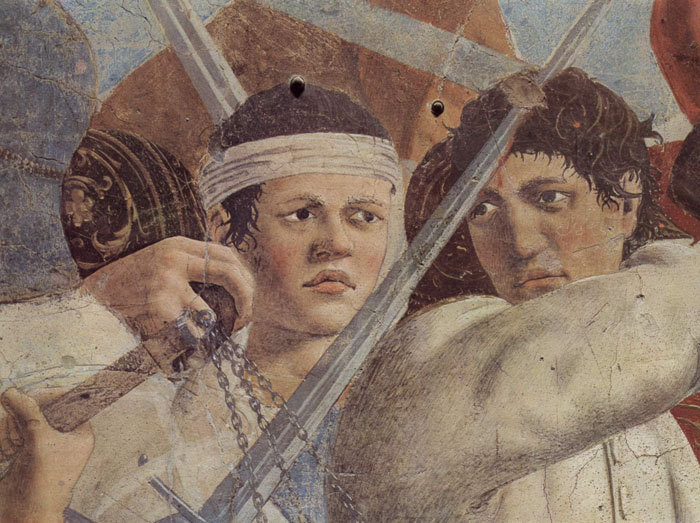
|
|
Piero della Francesca, Battle between Heraclius and Chosroes (detail), c. 1466, fresco, 329 x 747 cm, San Francesco, Arezzo
|
|
 |
|
| |
|
|
|
| |
|
Piero della Francesca, life and selected works
|
|
|
|
| |
|
Piero della Francesca (c. 1415 – October 12, 1492) is certainly one of the most important Italian painters of the XV century. His art was ample, monumental and rational, and represents one of the highest artistic ideals of the early Renaissance. The absolute mathematical rigour of his creations emphasises the abstract and iconic traits of his paintings and adds a powerful religious feeling to his masterpieces.
To contemporaries, he was known as a mathematician and geometer as well as an artist, though now he is chiefly appreciated for his art. By 1439 Piero della Francesca was working with Domenico Veneziano on frescoes for the hospital of Santa Maria Nuova in Florence. His experience and contacts in Florence, where he would have seen the works of such sculptors, artists, and architects as Donatello, Brunelleschi, Masaccio, and Fra Angelico, had a profound influence on Piero's style.
His painting was characterized by its serene humanism and its use of geometric forms, particularly in relation to perspective and foreshortening. In this work Piero enriches his knowledge of Florentine painting with a meditation on Flemish art. The court of Ferrara, where he stayed around 1448-50, offered a number of examples, notably a triptych by Roger Van der Weyden (1399/1400-1464).
Piero della Francesca was born in the town of Sansepolcro (former Borgo Santo Sepolcro), where he also died.
After his death, Piero was remembered mainly as a mathematician rather than as a painter. Even Vasari, who as a native of Arezzo must have known the frescoes in San Francesco well, is lukewarm in his enthusiasm for his work. However, he had considerable influence, notably on Signorelli (in the weighty solemnity of his figures) and Perugino (in the spatial clarity of his compositions). Both are said to have been Piero's pupils. |
|
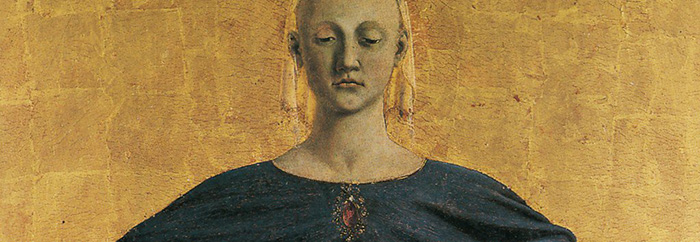 |
Piero della Francesca, Madonna della Misericordia, detail, 1445-1462, olio su tavola. Museo Civico, Sansepolcro
|
He may have learned his trade from one of several Sienese artists working in San Sepolcro during his youth. We hear of him also at various times in Ferrara, Rimini, Arezzo, Rome, and Urbino. But he found the origins of his style in Florence, and he probably lived there as a young man for some time during the 1430s, although he is documented there only once, in 1439 (the first known reference to him), when he was assisting Domenico Veneziano on frescoes (now lost) in S. Egidio.
Although Piero della Francesca began travelling at an early age and spent great part of his life working at the most important Courts in Central and Adriatic Italy, he never definitely bound himself to any Lord and always remained closely attached to his native town, so much so that he signed his works as “Pietro from Borgo”, as if to proudly underline his origins.
In 1442 Piero della Francesca returned to San Sepolcro where, three years later, he received the commission for the altarpiece of the Madonna della Misericordia, which he was to complete only in the early 1460s. In 1449 he executed several frescoes in the Castello Estense and the church of Sant'Andrea of Ferrara, also lost.
The polyptych of the Madonna della Misericordia was his first documented work, and shows that he had studied and absorbed the artistic discoveries of his great Florentine predecessors and contemporaries — Masaccio, Donatello, Domenico Veneziano, Filippo Lippi, Uccello, and even Masolino, who anticipated something of Piero's use of broad masses of colour.
Two years later he was in Rimini, working for Sigismondo Pandolfo Malatesta. In this sojourn he executed the famous fresco of Sigismondo Pandolfo Malatesta Praying in Front of St. Sigismund as well as the portrait of the condottiero. There he also met another famous Renaissance mathematician and architect, Leon Battista Alberti. Later he moved to Ancona, Pesaro and Bologna.
In 1452, Piero della Francesca was called to Arezzo to replace Bicci di Lorenzo in painting the frescoes of the basilica of San Francesco. The work was finished before 1466, probably between 1452-1456.
His cycle of frescoes depicting the Legend of the True Cross is generally considered among his masterworks and those of Renaissance painting in general.
In 1453, he returned to San Sepolcro where, the following year, he signed a contract for the polyptych in the church of Sant'Agostino. A few years later, summoned by Pope Nicholas V, he moved to Rome: here he executed frescoes in the Basilica di Santa Maria Maggiore, of which only fragments remain. Two years later he was again in the Papal capital, for frescoes in Vatican Palace which have also been destroyed.
Much of Piero's later career was spent working at the humanist court of Federico da Montefeltro at Urbino. There he painted the famous double portrait of Federico and his wife Battista Sforza, now in the Uffizi, the Madonna of Senigallia and the Nativity, and the celebrated Flagellation (still at Urbino, in the Ducal Palace), one of the most famous and controversial pictures of the early Renaissance.
Other notable works of Piero della Francesca's maturity include the Baptism of Fire, The Resurrection and the Madonna del parto.
Piero is last mentioned as a painter in 1478 (in connection with a lost work) and his two final works are probably The Madonna and Child with Federigo da Montefeltro (Brera, Milan, c. 1475) and the unfinished Nativity (National Gallery, London). Thereafter he seems to have devoted himself to mathematics and perspective, writing treatises on both subjects.
His deep interest in the theoretical study of perspective and his contemplative approach to his paintings are apparent in all his work, including the panels of the S. Agostino altarpiece. Three treatises written by Piero are known to modern mathematicians: Trattato d'Abaco; Libellus de quinque corporibus regularibus; De prospectiva pingendi. The subjects covered in these writings include arithmetic, algebra, geometry and innovative work in both solid geometry and perspective.
In his later years, painters such as Perugino and Luca Signorelli frequently visited his workshop. According to Vasari, he went blind in old age. Failing eyesight may have been his reason for giving up painting, but his will of 1487 declares him to be 'sound in mind, in intellect and in body' and is written in his own clear hand.
Piero della Francesca was buried in the Badia of Borgo San Sepolcro on 12 October 1492, the day when Columbus discovered America.
|
 |
Piero della Francesca, Madonna del Parto (detail), detached fresco, 203 cm, Museo della Madonna del Parto, Monterchi [3]
|
| Selected works
* Polyptych of the Misericordia (1445-1462) - Oil and tempera on panel, base 330 cm, height 273 cm, Pinacoteca Comunale, Sansepolcro
* The Baptism of Christ (c. 1448-1450) - Tempera on panel, 168 x 116 cm, National Gallery, London
* St. Jerome in Penitence (c. 1449-1451) - Oil on panel, 51 x 38 cm, Staatliche Museen, Berlin
* St. Jerome and a Donor (1451) - Panel, 40 x 42 cm, Gallerie dell'Accademia, Venice
* Sigismondo Pandolfo Malatesta Praying in Front of St. Sigismund (1451) - Fresco, Tempio Malatestiano, Rimini
* Portrait of Sigismondo Pandolfo Malatesta (c. 1451) - Tempera and oil on panel, 44.5 x 34.5 cm, Musée du Louvre, Paris
* The History of the True Cross (c. 1455-1466) - Frescoes, San Francesco, Arezzo
* St. Julian, Fresco, 130 x 105 cm Pinacoteca Comunale, Sansepolcro, 1455-60
* The Flagellation of Christ (c. 1460) - Tempera on panel, 59 x 81.5 cm, Galleria Nazionale delle Marche, Urbino
* Polyptych of Saint Augustine (1460-1470) - Oil and tempera on panel
* Resurrection (c. 1463) - Fresco, 225 x 200 cm, Museo Civico, Sansepolcro
* Madonna del parto (1459-1467) - Detached fresco, 260 x 203 cm, Chapel of the cemetery, Monterchi
* Nativity (c. 1470) - 124.5 x 123 cm, National Gallery, London
* Polyptych of Perugia (c. 1470) - Oil on panel, 338 x 230 cm, Galleria Nazionale dell'Umbria, Perugia
* Madonna and Child with Saints (Montefeltro Altarpiece, 1472-1474) - Oil on panel, 248 x 170 cm, Pinacoteca di Brera, Milan
* Paired portraits (c. 1472) of Federico da Montefeltro and Battista Sforza, respectively the Duke and Duchess of Urbino.
* Madonna di Senigallia (c. 1474) - Oil on panel, 67 x 53.5 cm, Galleria Nazionale delle Marche, Urbino
The last record we have of him painting was in 1478 but he lived on until 1492 - tragically, blindness seems to have blighted his last years.
[Chronology]
|
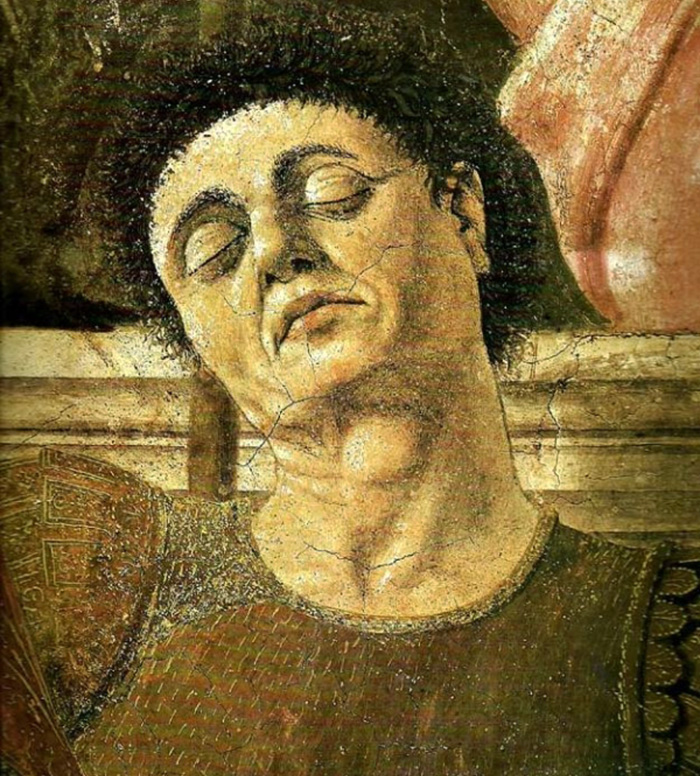 |
Piero della Francesca, The Resurrection, c. 1463-5, fresco, 225 x 200 cm (Museo Civico, Sansepolcro)
Giorgio Vasari, the great sixteenth century art historian and painter, believed that Piero included his own self-portrait in this fresco. The face of the soldier in brown armor was a self-portrait of Piero.
|
| |
|
|
|
Sansepolcro (former Borgo Santo Sepolcro), situated on the Tiber river in the province of Arezzo, was the birthplace of the painters Piero della Francesca, Raffaellino del Colle (a pupil of Raphael) and Angiolo Tricca. According to the tradition, the town was founded around 1000 AD by two pilgrims (Arcanus and Aegidius), who founded here an oratory (where now is the Cathedral) during their homecoming from the Holy Land. The historical centre Sansepolcro reached its current size around 1400, and in 1500 received its walls by Giuliano da Sangallo.
The Civic Museum of Sansepolcro (Palazzo della Residenza, constructed in the 13 C and 14 C) houses four works by Piero della Francesca, nd many other treasures including paintings by Santi di Tito, Raffaellino del Colle and Luca Signorelli. Its highlights are two of Piero della Francesca's main works: “La Resurrezione” and “La Madonna della Misecordia”.
English writer Aldous Huxley described the Resurrection by Piero della Francesca, which is in the Museo Civico, as "the greatest painting in the world".
|
Nel 1439 è documentato per la prima volta a Firenze, dove forse era avvenuta la sua vera formazione, forse già intorno dal 1435. Il 7 settembre infatti è citato tra gli aiutanti di Domenico Veneziano negli affreschi, oggi perduti, delle Storie della Vergine nel coro della chiesa di Sant'Egidio. La pittura luminosa, dalla tavolozza chiarissima e sontuosa, di Domenico Veneziano e quella, moderna e vigorosa, di Masaccio furono determinanti negli sviluppi del suo percorso artistico, ispirandogli alcune caratteristiche fondamentali che utilizzò per tutta la vita[2]. Con Domenico aveva probabilmente già collaborato a Perugia nel 1437-1438[6] e, secondo Vasari, i due lavorarono anche a Loreto, nella chiesa di Santa Maria, dove iniziarono ad affrescare «un'opera nella volta della sagrestia; ma perché, temendo di peste, la lasciarono imperfetta». La pittura fu successivamente terminata da Luca Signorelli.
La prima sua opera che ci è conservata è la Madonna col Bambino, già nella fiorentina Collezione Contini Bonacossi, attribuita per la prima volta a Piero nel 1942 da Roberto Longhi, che la fa risalire agli anni 1435-1440, durante i quali Piero era ancora collaboratore di Domenico Veneziano. Nel verso della tavola è dipinto un vaso, come esercitazione prospettica.
From 1920 to 1922 Longhi traveled in Europe with Alessandro Contini Bonacossi visiting churches, museums and private collections all across the continent.[1]
At the beginning of the Twentieth century Count Alessandro Contini Bonacossi returned to Italy from Spain with his wife Vittoria and two children Augusto Alessandro and Vittorina. While in Spain he was highly successful in the antique trade and began what was to become one of the largest private collections of paintings, furniture, ceramics and statues. Upon his death, his children Alessandro and Vittorina bequeathed the central part of this exceptional collection to the State.
Today the Contini Bonacossi donation is displayed in ten rooms which are part of the Uffizi Gallery, though not directly connected to the main building. Visits are only by appointment.
|
|
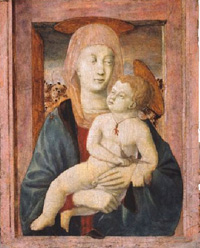
Madonna col Bambino (1435-1440), Collezione privata
|
| |
|
|
|
Polyptych of the Misericordia 1445-1462
|
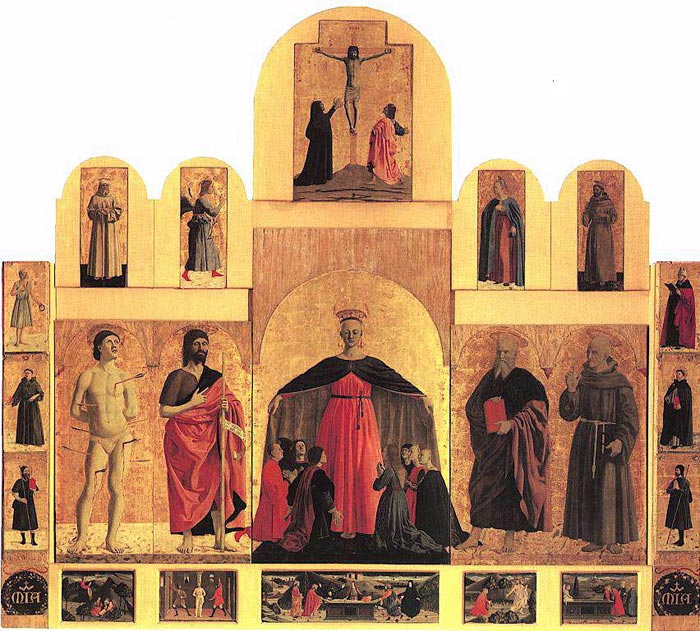 |
Piero della Francesca, Madonna della Misericordia, 1445-1462, olio su tavola. Museo Civico, Sansepolcro
|
Piero was commissioned the Polyptych by Sansepolcro’s Confraternity of Mercy in 1445.
The commission entailed extensive negotiations, which led to a contract with particularly precise and engaging clauses for the painter. The contract did not refer to the subject to be painted, though required the painter to reproduce the model of the existing painting (to be replaced); moreover, the artist was obliged to perform any necessary upkeep and restoration works for ten years after completion of the work.
As known, the contractual term (1448) was completely ignored due to Piero’s constant engagements in Arezzo and throughout Italy, where he worked for wealthier, more learned and refined Courts. Hence, the Polyptich took more than fifteen years to complete.
The iconography follows a traditional scheme: the Virgin Mary protects a group of believers, among whom also the artist (the first on her right). Despite the conventional golden background, Piero’s figures are given a significant plastic relief. The Virgin Mary’s pose, amplified by the wide drapery of her black cloak, is counterpointed by the precise representation of anatomic details.
One of the first paintings to be made was, quite likely, the one on the left, with San Sebastiano and San Giovanni Battista, formed by two joined axes: San Sebastiano probably reflects Piero’s first approach to Roman sculpture, while San Giovanni Battista is the most Masaccio-inspired figure ever painted by Piero. In any event, the most evident result of Piero’s direct and meditated study of Masaccio is the beautiful and touching Crucifixion, which may be compared with that currently held at Museum of Capodimonte.
The paintings originally composing the Polyptych, now kept at the Museum, are Our Lady of Mercy, San Sebastiano, San Giovanni Battista, Sant’Andrea, San Bernardino da Siena. Crucifixion, San Benedetto da Norcia, Announcing Angel, Our Lady of the Annunciation, and San Francesco da Assisi.
The foot-paces were clearly made by a modest painter, though a good miniaturist, possibly Giuliano Amedei. The two pilaster strips with the three Santi are of higher quality, and must thus have been made by a collaborator of Piero della Francesca.
[read more]
|
|
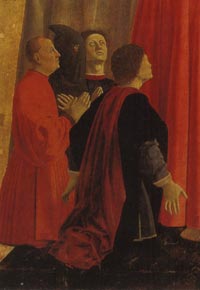 |
| |
|
|
|
Baptism of Christ (1460)
|
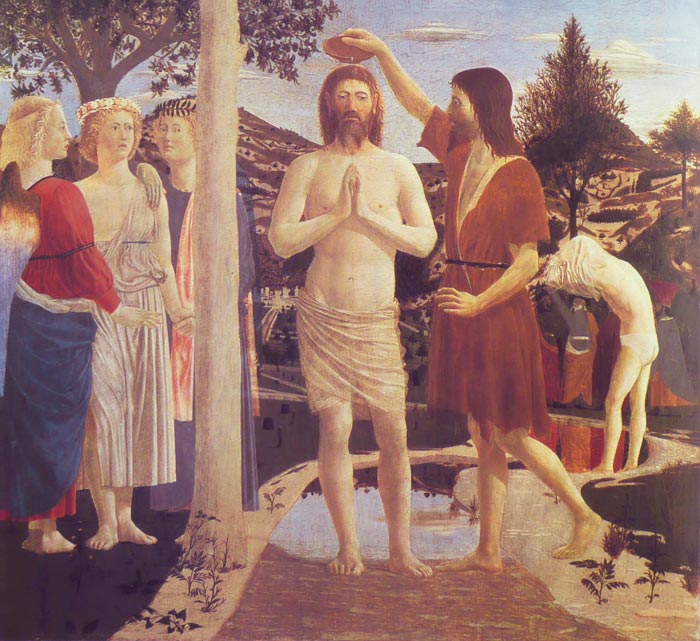 |
Piero della Francesca, The Baptism of Christ, detail (c. 1448-1450) - Tempera on panel, 168 x 116 cm, National Gallery, London
|
|
The Baptism of Christ is a good introduction to Piero della Francesca's style. Within an arched frame the baptism is taking place in a landscape strikingly similar to the countryside around San Sepolcro. In 1442 Piero della Francesca was recorded as town councillor in Borgo San Sepolcro. The Baptism of Christ portrays Christ being baptised by John, his head surmounted by a doverepresenting the Holy Spirit. Christ, John's hand, the bird and the bowl form an axis which divides the painting in two symmetrical parts. A second division is created by the tree on the left, which instead divides it according to the golden ratio.
The three angels wear different clothes and, different from the traditional iconography, are not supporting Christ's garments, but are holding each other's hands. This would be an allusion to the contemporary council of Florence (1439), whose goal was the unification of the Western and Eastern Churches.
[read more] |
|
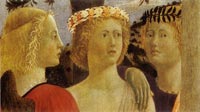 |
| |
|
|
|
The Penance of St. Jerome (1450)
|
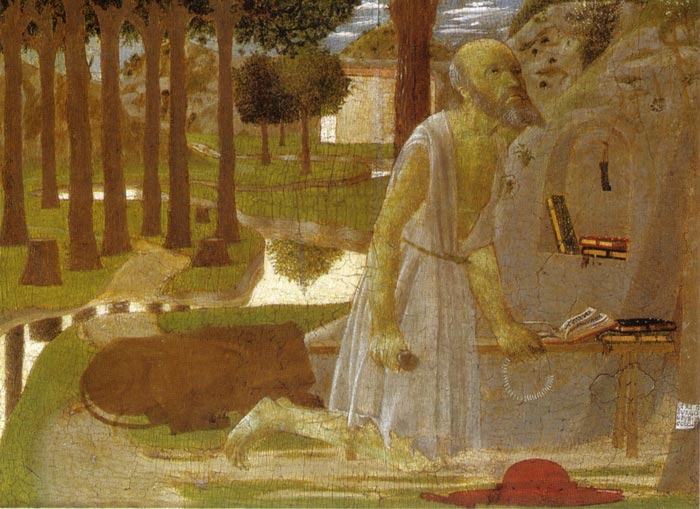 |
Piero della Francesca | St. Jerome in Penitence (detail), (c. 1449-1451) - Oil on panel, 51 x 38 cm, Staatliche Museen, Berlin
|
In 1451 Piero was in Rimini. Before that he painted two small panels, St Jerome and a Donor (in Venice) and Penance in St Jerome (in the Gemäldegalerie, Berlin). We do not know exactly for whom these were painted, but they are probably to be included amongst the "many of small figures" mentioned by Vasari as being commissioned by several rulers during the artist's journeys in the Marches and Emilia-Romagna. St. Jerome in Penitence is one of the two paintings by Piero that is dated. Recently it has been restored, and all the later additions have been removed from the background and the sky. We can now see, in the crystal-clear lighting, behind the hermit saint, a receding background with the perfectly straight tree trunks reflected in the winding river. The clear sky is barely dotted with little white pointed clouds.
[read more] |
| |
|
|
|
St. Jerome and a Donor (1451)
|
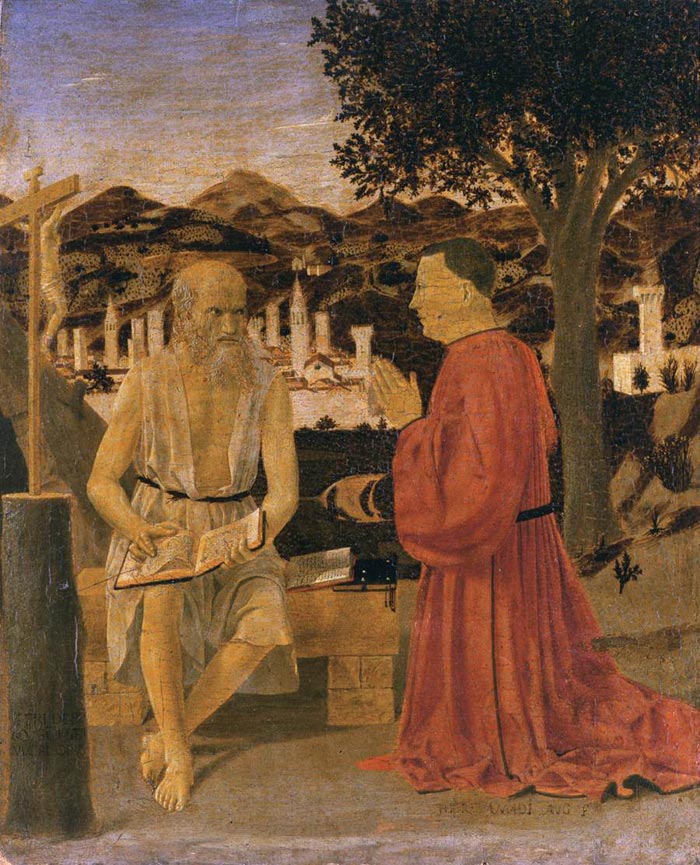 |
Piero della Francesca, St Jerome and a Donor, 1451, Panel, 49 x 42 cm; Gallerie dell'Accademia, Venice
|
In this small panel we can see for the first time Piero's signature, on the tree trunk that forms the base of the Crucifix in the left-hand corner. On the ground, in the foreground, there is also an inscription indicating that the panel was commissioned by Gerolamo Amadi "veneziano" who is shown kneeling in prayer before the saint. The donor and his protecting saint appear to be conversing as equals, for it was obviously Piero's intention to exalt the human dignity of his patron, as he was to do again in the case of Sigismondo Malatesta in Rimini. The bright hues of colour are similar to the clear sunlit atmosphere of the London Baptism of Christ, and even the background, with its rolling hills and steep country paths, confirms a vision of landscape that was first anticipated in the London painting.
Compared to Paolo Uccelo's nighttime, rather abstract and fairytale landscapes, or Fra Angelico's gentle and precious ones, Piero's are closer to Veneziano's, or even Masaccio's, with bare hills, partially covered with vegetation. And Piero makes his landscapes even more real and alive, for the vegetation is burnt out by a Mediterranean sun, the city walls are made of white lime and the water of the river is transparent.
[read more] |
| |
|
|
|
Sigismondo Pandolfo Malatesta Praying in Front of St. Sigismund (1451)
|
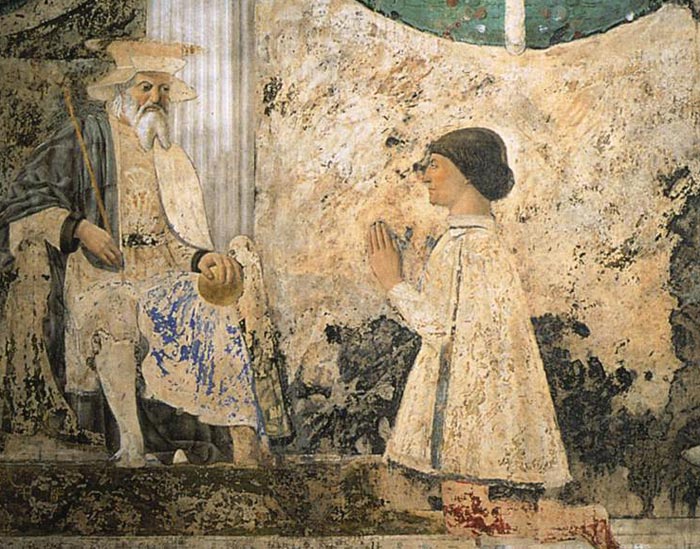 |
Sigismondo Pandolfo Malatesta Praying in Front of St. Sigismund (1451), fresco, Tempio Malatestiano, Rimini
|
Piero was favoured by some of the smaller city-states like Urbino and Rimini in central Italy. In 1449 Piero della Francesca executed several frescoes in the Castello Estense and the church of Sant’Andrea of Ferrara, also lost.
Two years later Piero della Francesca was in Rimini, and executed the famous fresco of Sigismondo Pandolfo Malatesta Praying in Front of St. Sigismund. For Sigismondo Malatesta, the lord of Rimini, he painted this devotional subject in the family's church known as the Tempio Malatestiano. He also painted the portrait of the condottiero. The painting portrays the condottiero and lord of Rimini and Fano Sigismondo Pandolfo Malatesta, and is housed in the Musée du Louvre of Paris.
The portrait depicts the condottiero by profile and, according to some sources, was based on a medal executed in 1445 by Pisanello, or to one by Matteo de' Pasti from 1450.
Despite the choice of the profile representation, typical of the portraits of eminent figures of the type, Piero della Francesca showed his attention for naturalist details in the fine execution of the texture and the hair of the committent. This is a proof of his good knowledge of Flemish masters such as Rogier van der Weyden.
In Rimini,
he met another famous Renaissance mathematician and architect, Leon Battista Alberti.
[read more] |
|
|
| |
|
|
|
| Probably between 1452 and 1458, taking over after the death of Bicci di Lorenzo, he began work on the fresco decoration of the main chapel in the church of San Francesco in Arezzo with its cycle of stories of the True Cross, recorded as completed only in 1466. |
| |
|
|
|
The Legend of the True Cross | Fresco Cycle in the Cappella Maggiore of San Francesco, Arezzo
|
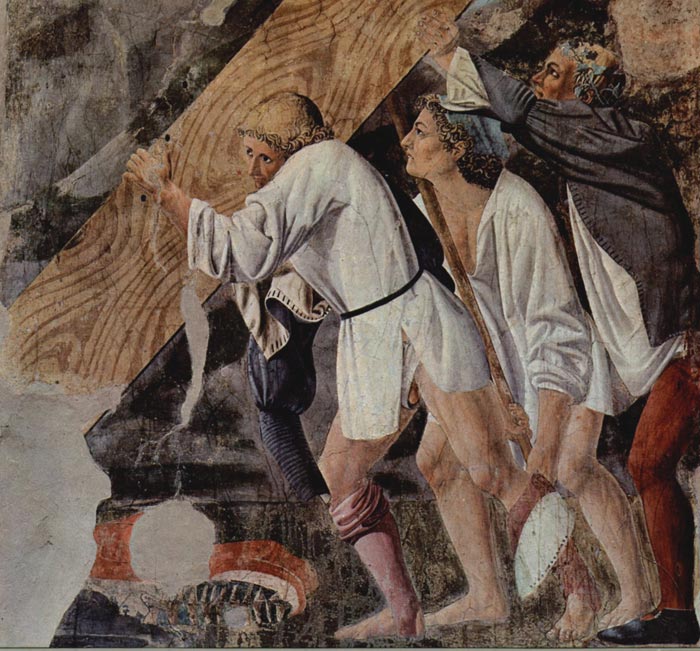 |
Piero della Francesca, Burial of the Wood, c. 1466, fresco 390 x 747 cm, (detail) San Francesco, Arezzo
|
Piero della Francesca’s major work is a series of frescos on the Legend of the True Cross in the choir of San Francesco at Arezzo (c. l452-c. l465). The subject was a medieval legend of great complexity, but Piero made from its fanciful details some of the most solemn and serene images in western art — even the two battle scenes have a feeling of grim deliberation rather than violent movement.
The Basilica of San Francesco is a late Medieval church in Arezzo, dedicated to St Francis of Assisi. The Cappella Maggiore houses the fresco cycle by Piero della Francesca depicting the Legend of the True Cross.This cycle of frescoes is in the Basilica di San Francesco, in Arezzo, and is the highest expression of the Renaissance art.
The 13th century Crucifix with Saint Francis was already in the church when Piero della Francesca frescoed the chapel; it has been recently placed above the main altar.
The painting of the chancel began with a commission by the Aretine family Bicci, who called the painter Bicci di Lorenzo to paint the large cross-vault. In 1452, at Bicci's death, only the four Evangelists had been painted in the vault, as well as the triumphal arch with the Last Judgement and two Doctors of the Church. Piero della Francesca was called in to complete the work. According to a document, he did so in two stages, the works halted during 1458-1459, and completed in 1466.[1]
Piero della Francesca’s fresco cycle of the Story of the True Cross is considered to be Piero della Francesca’s greatest masterpiece and narrates a medieval story about the cross on which Jesus was crucified. The theme of the fresco cycle derived from the popular 13th century book on the lives of saints by Jacopo da Varagine, the Golden Legend, is the triumph of the True Cross – the wood from the Garden of Eden that became the Cross on which Christ was crucified. The frescoes occupy three levels on the side walls and the eastern wall, surrounding a large window. Piero della Francesca did not follow a chronological order, preferring to concentrate himself in the creation of symmetrical correspondences between the various scenes.
[read more]
|
|
|
|
| |
|
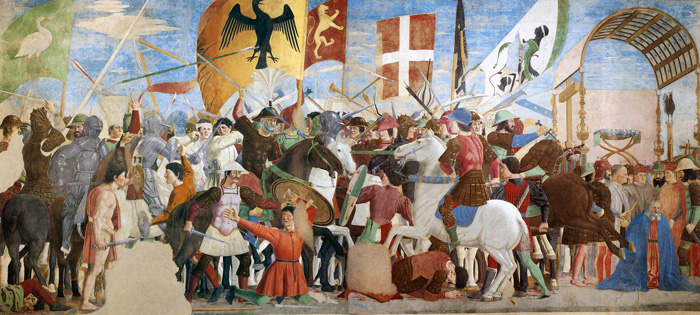 |
Piero della Francesca, Battle between Heraclius and Chosroes, c. 1466, fresco, 329 x 747 cm, San Francesco, Arezzo
|
| |
|
|
In 1455, Piero was in Rome, painting frescoes in the Vatican for Nicholas V and continued to work in the Vatican Palace also under Pius II. Piero della Francesca worked under Pope Pius II (Aeneus Sylvius Piccolomini) from 1458 to 1459, leaving some lost frescoes in the Apostolic Palace, probably destroyed to make room for the Raphael's Rooms. In 1467, Piero della Francesca returned to Sansepolcro where he held new public offices. He was commissioned to paint a Resurrection which is now one of his most famous works. |
| |
|
|
Saint Mary Magdalene (1460)
|
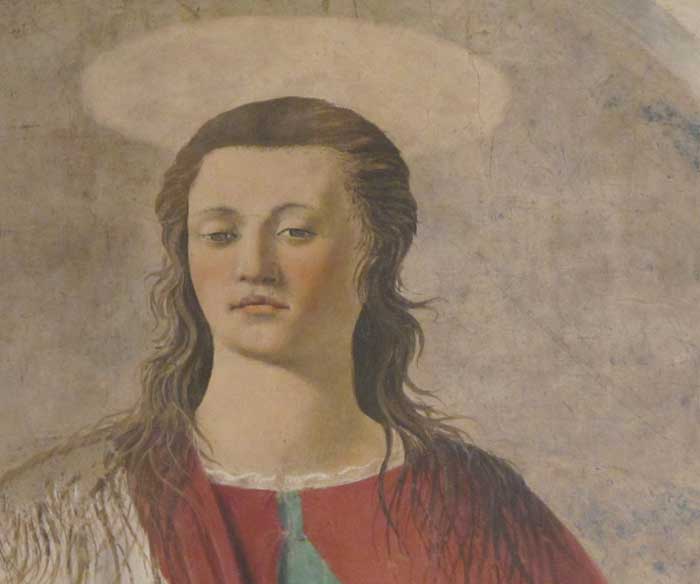 |
Piero della Francesca, fresco of Mary Magdalen in the Cathedral, Arezzo
|
More or less at the same time as he was working on the final scenes of the San Francesco cycle, Piero della Francesca was given another important commission in Arezzo: the fresco of Mary Magdalen in the Cathedral, situated near to the door of the sacristy.
This monumental figure is created entirely by large patches of bright colours, rather like an early 16th-century Venetian painting. Yet even with this new use of colour Piero still concentrates on the attention to detail typical of his mature works: the shining light reflections on the small bottle, the hair that is depicted strand by strand on the saint's solid shoulders.
|
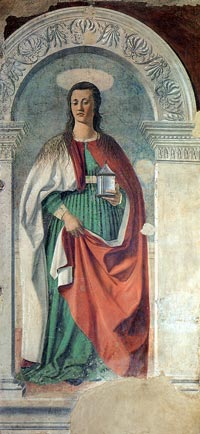 |
| |
|
|
St. Julian (1455-60)
|
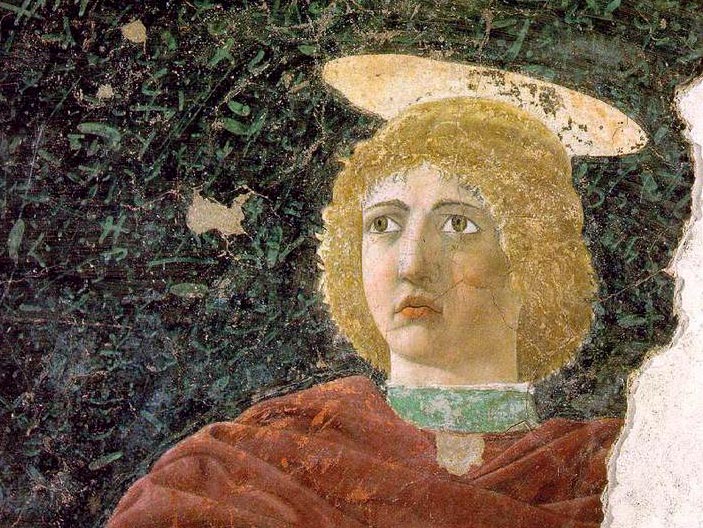 |
Piero della Francesca, St. Julian, fresco, 1455-60, 130 x 105 cm Pinacoteca Comunale, Sansepolcro
|
| In 1453, Piero della Francesca returned to Sansepolcro where, the following year, he signed a contract for the polyptych in the church of Sant'Agostino. St. Julian is the only fragment that has survived of Piero's fresco decoration of the church of Sant'Agostino in Borgo San Sepolcro. |
| |
|
|
| |
| A few years later, summoned by Pope Nicholas V, he moved to Rome: here he executed frescoes in the Basilica di Santa Maria Maggiore, of which only fragments remain. Two years later he was again in the Papal capital, for frescoes in Vatican Palace which have also been destroyed. To this period belongs The Flagellation (c. 1460), one of the most famous and controversial pictures of the early Renaissance. |
|
The Flagellation
|
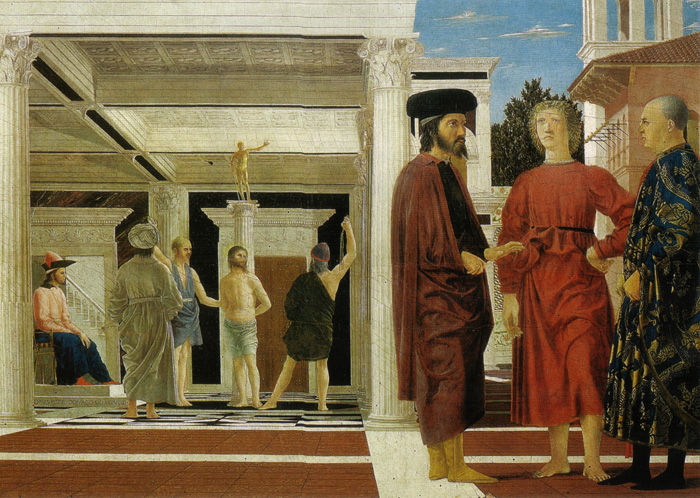 |
Piero della Francesca, The Flagellation, c. 1455, Oil and tempera on panel, 59 x 82 cm, Galleria Nazionale delle Marche, Urbino
|
The Flagellation was executed by Piero during his first visit to Urbino. rom the point of view of composition and perspective the painting is very rigorously planned. The composition appears to be divided into two scenes, separated by the column supporting the temple in which the Flagellation of Christ is taking place. Even though he is working in a unitary space, Piero does not give up his interest in detail, such as the ceiling of the temple or the bronze sculpture on the column with its splendid reflection of the light.
[read more] |
| |
|
|
Polyptych of Saint Augustine (1460-1470) |
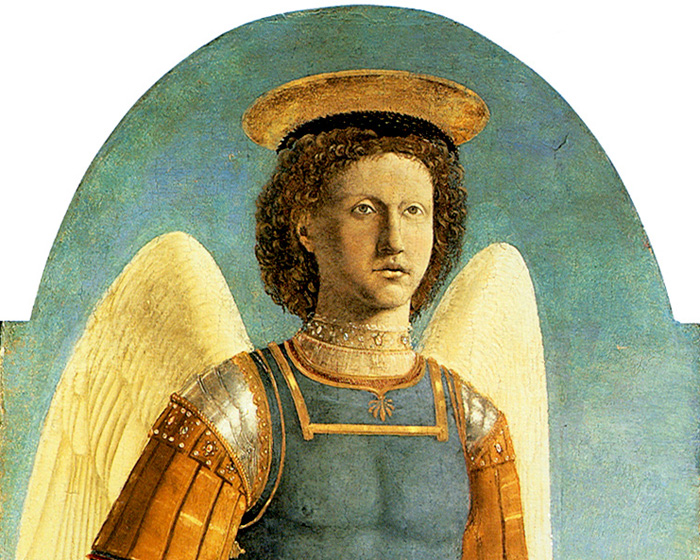 |
Polyptych of Saint Augustine (1460-1470), Saint Michael the Archangel, 133 x 59.5 cm, National Gallery, London
|
In 1453, Piero della Francesca returned to San Sepolcro where, the following year, he signed a contract for the polyptych in the church of Sant'Agostino. On pictorial grounds the following panels, placed from left to right, are associated with it: Saint Augustine (Lisbon); this Saint Michael (National Gallery, London) a missing central panel, perhaps of the Virgin and Child enthroned; an Unidentified Saint (Frick collection, New York), and Saint Nicholas of Tolentino (Poldi-Pezzoli Museum, Milan).
Archangel Michael is portrayed as an ancient warrior, his athletic limbs made more elegant by his precious armour, by the graceful tunic and by his beautiful boots decorated by with tiny pearls. There is nothing violent nor dramatic in the killing of the dragon, who is shown as a snake, its decapitated body lying on the ground.
[read more] |
| |
Resurrection of Christ
|
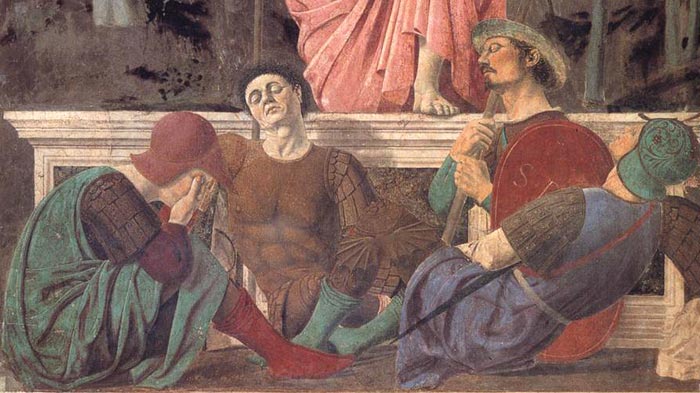 |
Piero della Francesca, The Resurrection of Christ (detail) (c.1420 - 1492), mural in fresco and tempera, Museo Civico, Sansepolcro
|
The fresco was probably painted in 1467-68, in the Meeting Hall of Palazzo dei Conservatori di Sansepolcro (the current Civic Museum).
It is one of the greatest works by Piero della Francesca: an emblematic work, symbol of the artist’s native town which, so goes the legend, was founded as a result of worshipping the relics of Saint Sepolcro brought by two pilgrims, Egidio and Arcano.
Under the sign of the resurrected Christ, the town, which passed under the rule of Florence for a few years (1441), regained its identity and dignity in 1456 when the Florentines returned the use of the Palazzo to the Conservatori and to two Councils, in order for them to regain their official use: restoration thus began, during which the realization of the work was probably planned. The painting shows Christ in a strong and authoritative pose; what is impressive is his fixed look: not a sign of transcendental detachment, but rather a strong human trait, a divine “presence”. On the left, there is a barren, winter-like and abandoned landscape; on the right, instead, the landscape is spring-like, peaceful and pleasant. A number of soldiers sleep at Christ’s feet, forming the basis of a pyramid with Christ and thus defining the space on two separate levels (the space under the banner is thought to be Piero’s self-portrait).
The composition is divided in two parts, each with its own separate perspective. The lower part, where the guards are sleeping, has a very low point of view which gives the scene monumental stability. Above them, Piero portrayed Jesus Christ, who is not seen from below, but has a perfectly frontal point of view. The Resurrected is a perfect representation of Piero's ideal man: practical and measured, but at the same time solemn. The splendid landscape also belongs to the folklore: Piero symbolically painted it half in winter and half coming back to life, i.e. resurrecting, in spring.
[read more] |
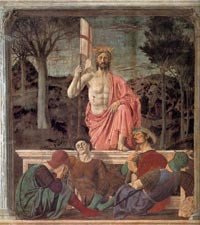
|
| |
Madonna del parto (1459-1467)
|
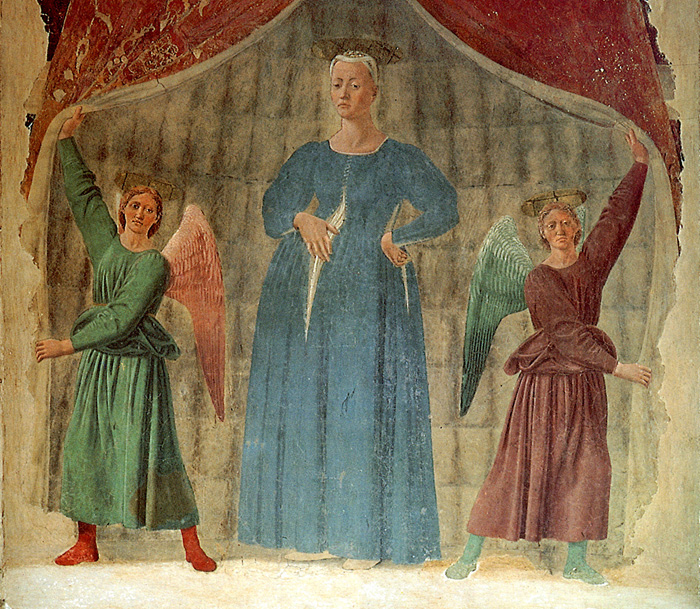 |
Piero della Francesca, Madonna del parto (1459-1467) - Detached fresco, 260 x 203 cm, Chapel of the cemetery, Monterchi
|
The original location of Piero della Francesca's Madonna del Parto, is the Capella di Cimitero of the Santa Maria della Momentana in Monterchi, near Arezzo. The edifice was destroyed in 1785 by an earthquake and the work was detached and placed over the high altar of the new cemetery chapel and in 1992 it was moved to the Museo della Madonna del Parto in Monterchi.
The figure of this Madonna, the protector of pregnant women, with her austere expression and natural stance of a woman heavy with child, stands out against the damask canopy, held open at the sides by two angels. The sacred and ritual nature of the image is further emphasized by the fact that the angels are drawn from the same cartoon, repeated in mirror image.
The work was attributed to Piero della Francesca only in 1889. Its dating has been the subject of debate, ranging from 1450 to 1475. The 16th century artist and writer Giorgio Vasari wrote that it was completed in 1459, when Piero della Francesca was in Sansepolcro for his mother's death.
The fresco also plays an important role in Andrei Tarkovsky's film Nostalghia.
[read more] |
| |
|
|
The last phase of his activity was marked by an increasingly capillary realism investigating the varying effects of light. To this period belong such masterpieces as the Madonna of Senigallia (Galleria Nazionale, Urbino), the Virgin and Child with Angels (Sterling and Francine Clark Art Institute, Williamstown, Mass.), and a Nativity (National Gallery, London), which is his last surviving work.
|
Nativity (c. 1470)
|
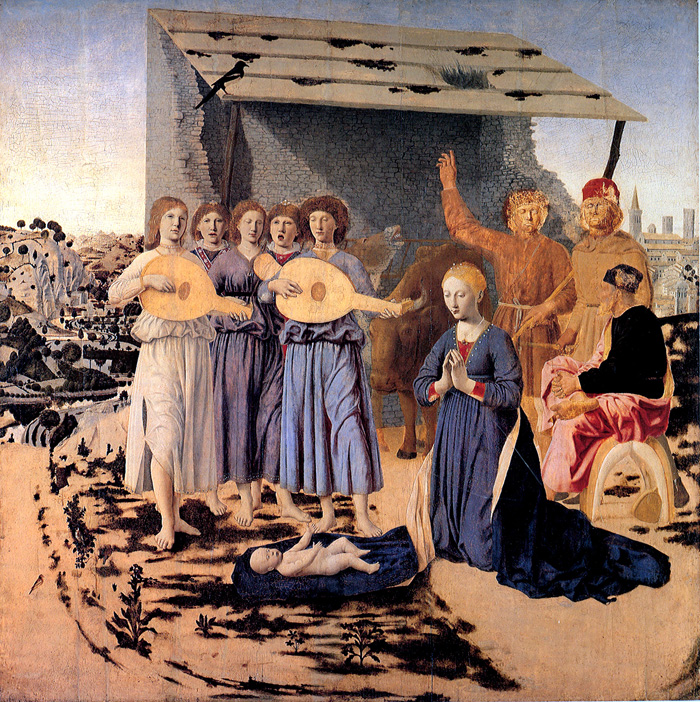 |
Piero della Francesca, Nativity (c. 1470) - 124.5 x 123 cm, National Gallery, London
|
| |
This scene shows Mary kneeling in adoration before a newly-born Christ who is laid on her cloak. Five angels sing welcoming his birth - two of them play lutes. Beside them a donkey appears to bray, while an Ox peers down solemnly at Christ.
Two shepherds are present (their faces have lost detail, possibly through over-zealous cleaning by previous owners). One of the shepherds points heavenwards, clutching his staff like a sceptre. Joseph is shown in deep contemplation, with his leg crossed over his knee. Each person, angel and animal shows a different attitude of reverence towards the infant Christ. Even the magpie, well-known in Piero's native Tuscany for its constant chatter, seems changed and looks to be struck silent.
Piero has added other touches from his native region - Bethlehem itself has a distinctly Tuscan feel. The flat land on top of the hill where they stand evokes Tuscany, as does the winding valley to the left. Meanwhile the skyline on the right, dominated by the basilica, could almost be the outskirts of Piero's home town Borgo Sansepolcro.
The influences here come from further a field than Tuscany. The painting shows the impact of Northern European painting. Piero painted with tempera early in his career, but for later works like this one he began working in oil. Along with the use of brown under-painting for the figures, this shows a familiarity with Netherlandish and Flemish work. This is reinforced by the slim figure of Christ, who lacks the square muscularity of contemporary depictions from Italy, and is more reminiscent of paintings by artists like Hugo van der Goes.
Piero has also experimented with perspective. It is the only one of his works that shows a building askew from the rest of the composition: this is the simple shed, which reminds the viewer of Christ's humble beginnings.
It is possible that this panel was never completed. It has certainly been damaged, possibly by the work of a 19th-century restorer. Nevertheless, the painting holds more than enough detail to give a sense of a complete composition, one which is likely to have been among the last the artist created.
[read more] |
| |
Polyptych of Perugia, also known as Polyptych of Saint Anthony (1460-1470)
|
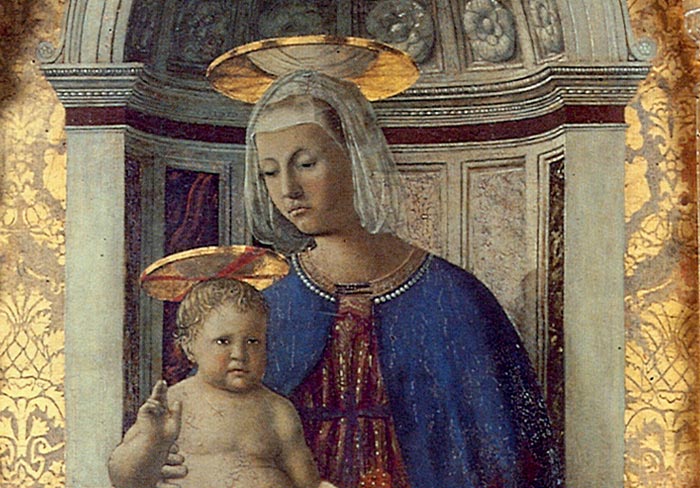 |
Piero della Francesca, Polyptych of St. Anthony, Oil and tempera on panel, 338 cm × 230 cm, Galleria Nazionale dell'Umbria, Perugia
|
Among the many works that, according to Vasari, Piero painted in Perugia, the historian describes with great admiration the polyptych commissioned by the nuns of the convent of Sant'Antonio da Padova. This complex painting, today in the Pinacoteca Nazionale in Perugia, was begun shortly after Piero's return from Rome, but was not completed for several years.
[read more]
|
| |
Madonna and Child with Saints (Montefeltro Altarpiece, 1472-1474)
|
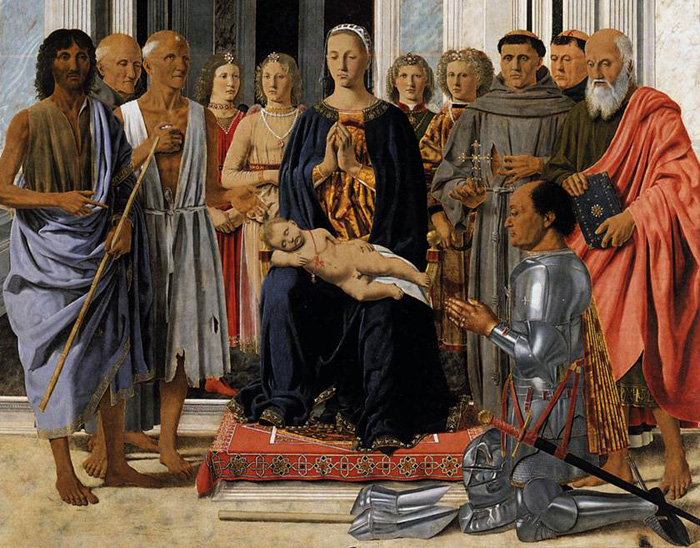 |
Piero della Francesca, Madonna and Child with Saints (Montefeltro Altarpiece, 1472-1474) - Oil on panel, Pinacoteca di Brera, Milan
|
The Brera Madonna (also known as Pala di Brera, Montefeltro Altarpiece or Brera Altarpiece) was executed by Piero della Francesca in 1472-1474. It is housed in the Pinacoteca di Brera of Milan.
It was commissioned by Federico III da Montefeltro, Duke of Urbino, to celebrate the birth of Federico's son, Guidobaldo. According to this hypothesis, the Child could represent Guidobaldo, while Virgin may have the appearance of Battista Sforza, Federico's wife, who died in the same year and was buried at San Bernardino.
According to other sources, the Montefeltro Altarpiece would celebrate his conquest of several castles in the Maremma.
The work represents a sacra conversazione, with the Virgin enthroned and the sleeping Child in the middle, surrounded by a host of angels and saints. On the right low corner, kneeling and wearing his armor, the Duke, patron of arts and condottiero Federico da Montefeltro. The background consists of the apse of a church in Renaissance classical style.
Federico III da Montefeltro appears as a donor kneeling in the lower right. He wears military garb and holds his helmet, properly removed as a sign of respect.
[read more] |
| |
|
|
Federico da Montefeltro and Battista Sforza (c. 1472)
|
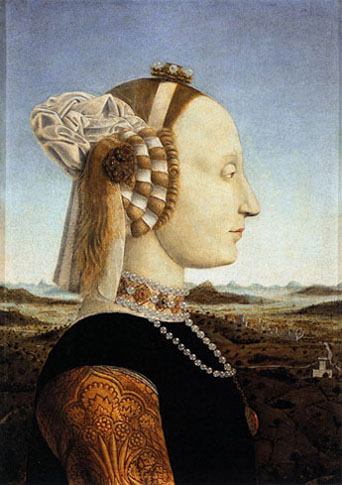 |
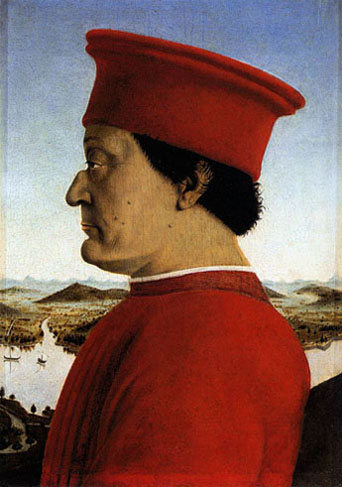 |
| |
|
Portraits of Federico da Montefeltro and His Wife Battista Sforza (1465-66), Panel, 47 x 33 cm (each), Galleria degli Uffizi, Firenze
|
| |
For Duke Federico da Montefeltro and his wife, Battista Sforza, Piero painted the double portrait diptych in the Galleria degli Uffizi, Florence, usually dated 1472, the date of Battista's death, but probably executed in 1465, as well as the famous San Bernardino altarpiece (Madonna and Child with Saints or Montefeltro Altarpiece), in 1474-1475.
Federico da Montefeltro was born in 1422 to a small-time noble family that ruled over an insignificant square of the chess-board that was then central Italy. Yet within sixty years he had become "the light of Italy" and the paradigm of Renaissance man, as skilled in letters as in arms.
Piero's ability in rendering volumes is accompanied by his attention to detail. Through his use of light, he gives us a miniaturistic description of Sforza's jewels, of the wrinkles, moles and blemishes on Federico's olive-coloured skin. As in all portraits of the Duke, including this one by Piero della Francesca, we only see his left profile; a swordblow earlier in his life had cost him his right eye and the bridge of his nose.
[read more]
|
| |
|
|
Madonna di Senigallia (c. 1474)
|
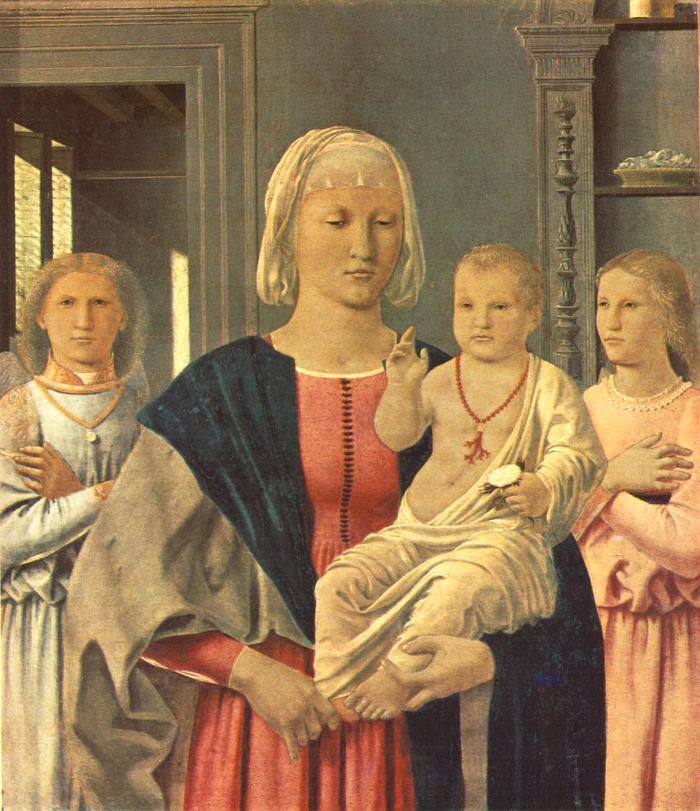 |
Piero della Francesca, Madonna di Senigallia (c. 1474) - Oil on panel, 67 x 53.5 cm, Galleria Nazionale delle Marche, Urbino
|
The Madonna di Senigallia is a painting by the Italian Renaissance master Piero della Francesca, finished around 1474. It is housed in the Galleria Nazionale delle Marche, in the Ducal Palace of Urbino.
The painting was originally in the church of Santa Maria delle Grazie extra moenia of Senigallia (Marche), whence the current name.
The 1950s restoration showed the high quality of Piero della Francesca's treatment of light, as well as the influence of Flemish masters on it in details such as the basket with linen gauze, the coral and the fabric covering the Madonna's head. The light, which realistically enters from the window on the left, is a symbol of the Virgin's conception. The linen in the basket is instead an allusion to her purity, while the case for hosts in the shelf and the coral hanging from Jesus' necklace both hint to the Eucharist sacrifice. The staring, thoughtful immobility of all the characters would be also an allusion to the latter.
[read more] |
| |
|
|
Virgin and Child Enthroned with Four Angels
|
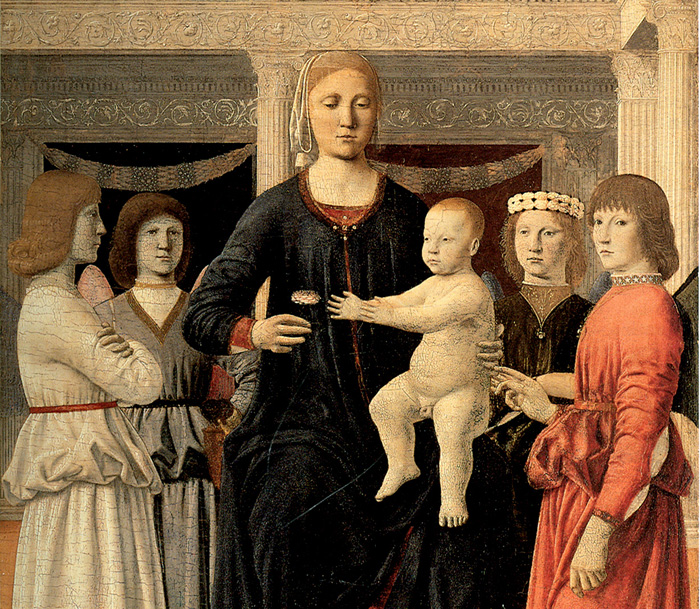 |
Piero della Francesca, Virgin and Child Enthroned with Four Angels, c. 1460-70, Williamstown, Sterling and Francine Clark Art Institute
|
This extremely rare painting by a key figure of the early Renaissance in Italy was one of Sterling Clark's first purchases. The composition centers on the statuesque Virgin Mary, who holds a robust Christ Child on her knee; Christ reaches for a pink carnation, a symbol of the crucifixion. The stately angels, solid as columns, stand as sentinels, while the precisely calibrated architecture forms the idealized setting.
[read more] |
| |
|
|
Hercules
|
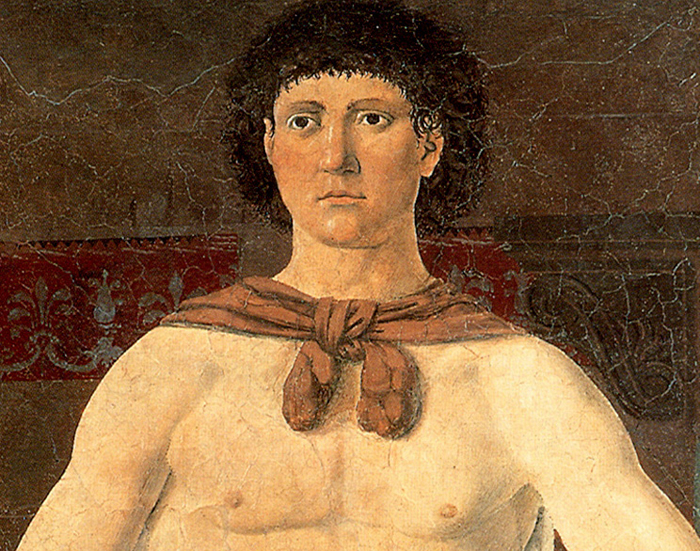 |
Piero della Francesca, Hercules, frecso transferred on canvas, 151 x 126 cm, Boston, Isabella Steward Gardner Museum
|
Piero della Francesca's "Hercules", a fresco in the Isabella Stewart Gardner Museum in Boston, and the painter's only secular work, is unique among his paintings in many respects. Although its authenticity as an autograph work has never been questioned, it is usually neglected in the literature on Piero. The fresco comes from the painter's own house in Borgo San Sepolcro and thus is an exceptional case of an artist's self-patronage. The analogy of composition and dimensions with Piero's later portrait, as well as iconographic attributes of the virtue of Prudence and some other clues, lead the author to make a convincing notion that the "Hercules" is Piero's self-portrait, what is more, a "moral" one, characterising him as an artist.
[read more]
|
Proiezioni di una testa scorciata dal de Prospectiva Pingendi, ante 1482, Milano, Biblioteca Ambrosiana
|
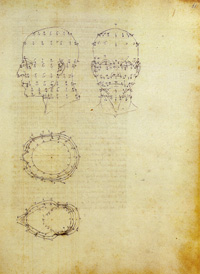 |
|
|
| |
|


Podere Santa Pia is an old farm that has been renovated into a perfect holiday house located 350 meters above sea level. Although this is off the beaten track it is the ideal choice for those seeking a peaceful, uncontaminated environment.
Numerous other towns and villages offer a treasure trove of history and art waiting to be discovered. The central location of the holiday home allows you to visit the nearby beautiful villages Montalcino, Sant'Antimo, Pienza, S. Quirico d'Orcia and in the south Saturnia and Sorano - known for its beautiful Sasso Leopoldo. And the sea is 38km away in Marina di Grosseto.
Holiday homes in the Tuscan Maremma | Podere Santa Pia
|
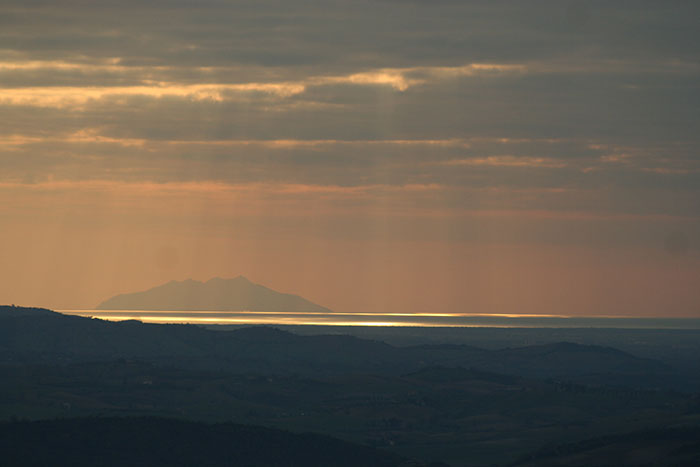 |
Podere Santa Pia, evening view over the Maremma hills and Montecristo
|
|
|

. |
|
|
Podere Santa Pia |
|
Podere Santa Pia, garden view, December |
|
 Follow us on Instagram Follow us on Instagram
|
| |
|
|
|
|
|
|
|
|
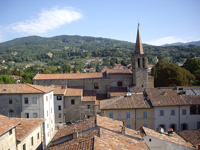
|
Arezzo |
|
Perugia |
|
Sansepolcro |
| |
|
|
|
|
| |
|
|
|
|

[1] Carlo Bertelli, Piero della Francesca, New Haven & London, Yale University Press, 1992, p. 79.
[2] Roberto Longhi was a famous italian art historian. Longhi studied under Pietro Toesca at the University of Turin where he was granted a degree in 1911 after presenting a dissertation on Caravaggio. An interview on Cosmè Tura gained him admission to Adolfo Venturi's post graduate course in Rome in 1912. The subjects of his early publications range from 15th century painting (Piero della Francesca e lo sviluppo della pittura veneziana) to avant garde art criticism (I pittori futuristi e Scultura Futurista Boccioni), and include essays on Caravaggio (Due opere di Caravaggio) and his followers: Mattia Preti (pure figurative criticism), Orazio Borgianni, Battistello, Gentileschi father and daughter. From 1920 to 1922 Longhi traveled in Europe with Alessandro Contini Bonacossi visiting churches, museums and private collections all across the continent. From 1922 he worked as a university lecturer in Rome. In 1926 he began to contribute to the periodical 'Vita Artistica' which he directed from 1927 with Emilio Cecchi. The following year Longhi and Cecchi founded the periodical 'Pinacotheca'. In 1927 Longhi published his famous monograph Piero della Francesca, which was translated into French the same year and into English in 1931. It was followed in 1934 by Officina Ferrarese. In 1934 Longhi was also named professor of Medieval and Modern Art at the University of Bologna. Between 1935 and 1936 he organized the Mostra del Settecento bolognese, the exhibition of 18th century Bolognese art. From 1938 to 1940 he directed the periodical 'La Critica d'Arte' in Florence. Longhi's well known essay Ultimi studi sul Caravaggio e la sua cerchia was published in 1943. In 1950 Longhi founded the periodical 'Paragone' which he directed until he died, contributing important editorials on cultural policy and essays on a variety of art historical subjects. In 1949 Longhi became a professor at the University of Florence. Longhi conceived and organized two memorable exhibitions on Giuseppe Maria Crespi (1948) and on Bolognese 14th century painting (1950), both held in Bologna. He also organized the famous exhibit on Caravaggio e i caravaggeschi (1951) which was held in Milan. Longhi's monograph on this Lombard painter appeared the following year. In the same period Longhi collaborated with Umberto Barbaro, producing documentaries about several artists (Carpaccio, Caravaggio, Carrà). His book entitled Il Correggio e la camera di San Paolo a Parma dates from 1956. When Longhi died in 1970 he left his collections of art, photographs and books 'for the benefit of future generations' in his villa in via Fortini which is now the site of a foundation bearing his name.
[3] Photo by Sailko, licensed under the Creative Commons Attribution 3.0 Unported license.
|

Art in Tuscany | Giorgio Vasari's Lives of the Artists | Piero della Francesca
Giorgio Vasari | Le vite de' più eccellenti architetti, pittori, et scultori italiani, da Cimabue insino a' tempi nostri | Piero della Francesca
All modern scholarship concerning Piero della Francesca derives from the pioneering work of Roberto Longhi. Longhi's works, which date from 1914 to 1942, are in Italian, but the fruits of his discoveries have been incorporated in English-language works. Kenneth Clark's readable monograph is Piero della Francesca (1951; 2d ed. 1969). Also useful is Piero Bianconi, All the Paintings of Piero della Francesca (trans. 1962). Bernard Berenson wrote interesting essays on Piero in his Central Italian Painters of the Renaissance (1897; 2d rev. ed. 1909) and Piero della Francesca; or, The Ineloquent in Art (1954).
Giorgio Vasari | Lives of the Most Eminent Painters Sculptors and Architects, Piero della Francesca
Piero della Francesca On-line: Story of the True Cross, San Francesco, Arezzo (Italy) | Aronberg Lavin, M., et al., Piero Della Francesca On-line: Story of the True Cross, San Francesco, Arezzo (Italy): Figure 7. In J. Trant and D. Bearman (eds). Museums and the Web 2009: Proceedings. Toronto: Archives & Museum Informatics. Published March 31, 2009. | www.archimuse.com
Film in Toscana | Arezzo, Sansepolcro and Monterchi, the homeland of Piero della Francesca
In the footsteos of Piero della Francesca | Piero della Francesca in central Italy
Piero della Francesca and his landscapes | The balconies is Piero della Francesca
Marcello Simonetta, The Montefeltro Conspiracy: A Renaissance Mystery Decoded, New York, Doubleday, 2008. (L'enigma Montefeltro. Milano: Rizzoli, 2008.)
In Florence, on April 26, 1478, Lorenzo de Medici, soon to be dubbed “the Magnificent,” and his brother, Giuliano, were set upon by assassins during Sunday mass. Giuliano died, but Lorenzo survived and became one of the most accomplished of Renaissance figures as a patron of the arts and a skillful leader of the Florentine Republic. The assassination attempt, generally called “the Pazzi conspiracy,” was immediately blamed on a rival Florentine family, the Pazzi. Simonetta, a professor of Italian history and literature, has uncovered another layer of the plot. Aided by a recently decoded letter found in an archive in Urbino, Simonetta indicts Frederico de Montefeltro, the widely admired Duke of Urbino. Montefeltro, often referred to as “the Light of Italy,” was a classics scholar, a humanist, and a supposed friend of the Medici family. He was also a tough, ruthless mercenary quite at home in the cutthroat milieu of fifteenth-century Italian politics.
Lavin, M.A. , Piero della Francesca. London, Phaidon Press, 2002
Marilyn Aronberg Lavin, Piero Della Francesca: San Francesco, Arezzo (The Great Fresco Cycles of the Renaissance), New York, George Braziller, 1994
Carlo Bertelli, Piero della Francesca, New Haven & London, Yale University Press, 1992
Bertelli's densely reasoned monographic study of the early Renaissance master Piero della Francesca proffers a plethora of provocative but not equally compelling insights into the artist's life, work, and style. An excellent complement to Bertelli's work is Ronald Lightbown's Piero della Francesca ( LJ 7/92). While scholars will need to ponder the somewhat divergent conclusions of both authors, general readers are better served by Lightbown's engaged evocation of the works themselves and by his coherent arguments and lucid prose.
Ronald Lightbown, Piero Della Francesca, Abbeville Press, 1992
From Filippo Lippi to Piero della Francesca: Fra Carnevale and the Making of a Renaissance Master | The exhibition was organized by The Metropolitan Museum of Art, New York, and the Soprintendenza per il Patrimonio Storico Artistico e Etnoantropologico, Milano.
Two cities—Florence and Urbino; a key moment in the history of Italian Renaissance art; 55 works by some of the greatest painters and sculptors, including Filippo Lippi, Domenico Veneziano, Piero della Francesca, and Luca della Robbia, as well as eccentric paintings by little-known masters; and the identification of a heretofore mysterious personality who practiced painting and sculpture and was associated with the celebrated court of Urbino: these are the ingredients of this jewel-like exhibition.
The exhibition catalogue is made possible by Bracco, the Oceanic Heritage Foundation, and the Samuel I. Newhouse Foundation Inc.
Machtelt Israëls: "Piero at Home: The Art of Piero della Francesca" | www.frick.org
During the early Renaissance, Piero della Francesca’s artistic talents were highly sought after by patrons across the Italian peninsula but nowhere more so than in his hometown of Borgo San Sepolcro. Israëls' lecture explores how Piero gradually transformed the art of painting by applying his pioneering pictorial imagination to the challenge of three gothic polyptychs and by introducing Renaissance format paintings into the domestic interior with hisVirgin and Child Enthroned with Four Angels and Nativity of Christ (The National Gallery, London).
The Private Life of a Masterpiece was a BBC arts documentary series which told the stories behind great works of art. The series reveals the full and fascinating stories behind famous works of art, not just how they came to be created, but also how they influenced others and came to have a life of their own in the modern world.
The Private Life of a Masterpiece, episode 22 | Piero della Francesca, The Resurrection
Famous texts | Aldous Huxley, The Best Picture”
Film in Tuscany | Arezzo, Sansepolcro and Monterchi, the homeland of Piero della Francesca
|
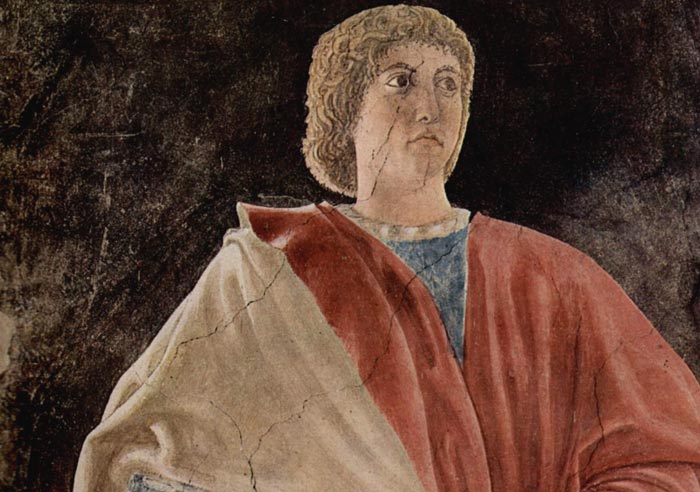 |
Piero della Francesca, The Old Testament Prophet Jeremiah (detail), c. 1466, fresco, 329 x 747 cm, San Francesco, Arezzo
|
| |
|
|
|
|
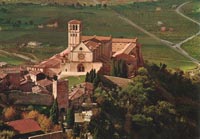 |
|
|
Montefalco |
|
Assisi |
|
Florence, Duomo |
| |
|
|
|
|
| |
|
|
|
| |
|
|
|
| |
|
|
|
| |
|
|
|
| |
|
|
|
| |
|
|
|
![]()













